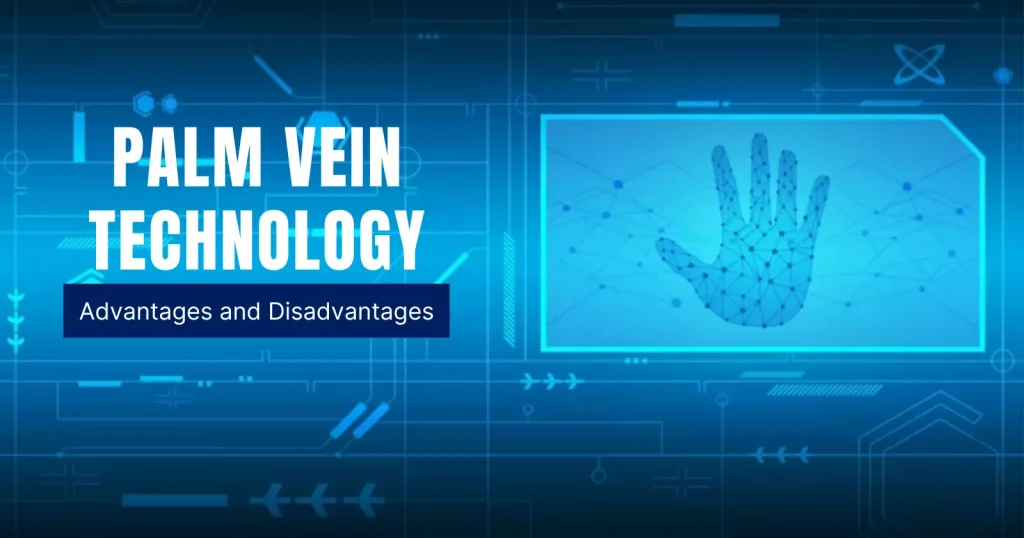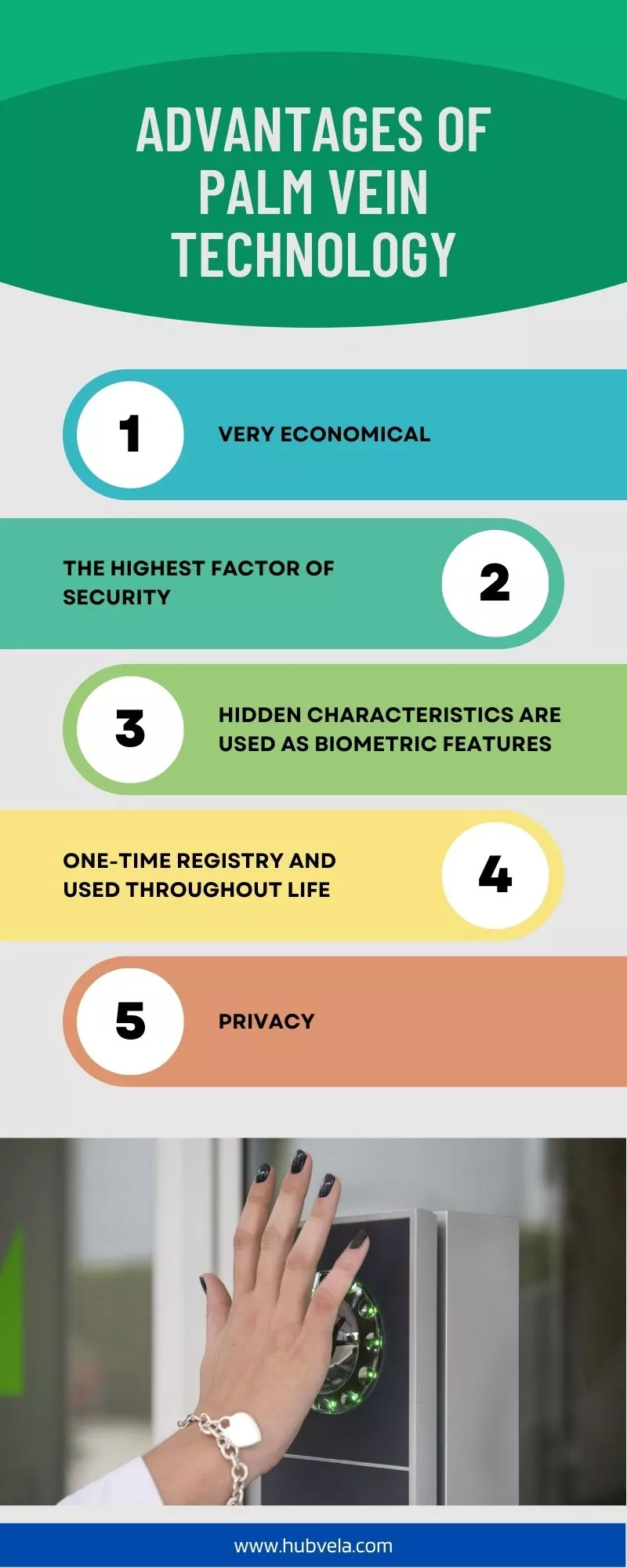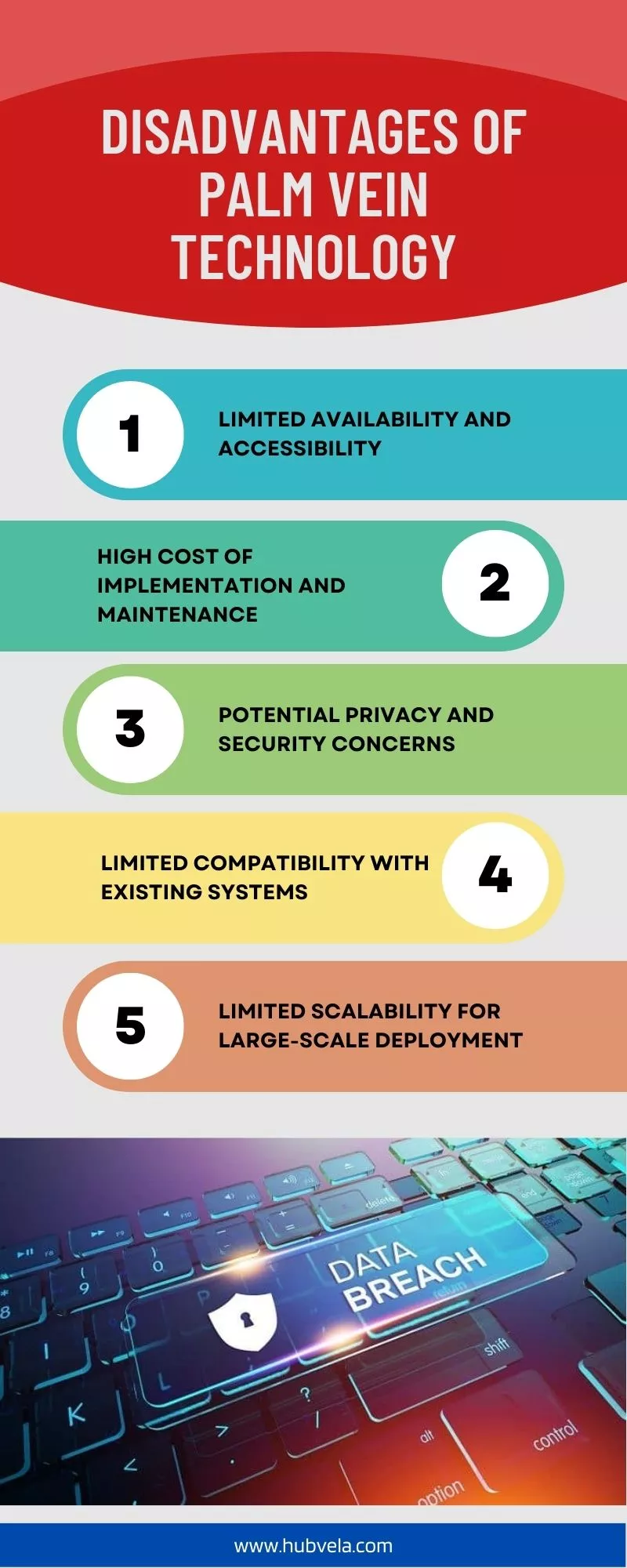In a world where biometric technologies are rapidly evolving, palm vein technology is a revolutionary security measure that provides both advantages and disadvantages.
This cutting-edge form of authentication utilizes intricate patterns of veins in the human hand to verify identity, offering unparalleled levels of security in the digital age.
However, as with any new technology, there are trade-offs to consider when weighing the potential benefits against any potential drawbacks.
In this article, we will discuss the advantages and disadvantages of palm vein technology.

--Advertisement--
Advantages of Palm Vein Technology
Palm vein technology has revolutionized the way we think about security and authentication. By leveraging a unique biometric system, palm vein recognition provides a secure and reliable means of verifying identity.
This cutting-edge technology offers several distinct advantages that make it an attractive option for businesses looking to upgrade their security protocols.
For starters, palm vein authentication is incredibly accurate – much more so than traditional methods such as passwords or ID cards.
This is because the network of veins in your hand is virtually impossible to replicate or forge due to their intricate nature and complexity.
Additionally, this type of technology requires no physical contact with the scanner, making it hygienic and easy to use for customers who may be wary of fingerprinting or eye-scanning systems.

1. Very Economical
As the world progresses into a digital age, so does the need for new and improved technologies to help revolutionize the way we live.
One of these technological advancements is Palm Vein Technology: an economical yet highly efficient biometric technology that can provide multiple advantages to businesses and individuals alike.
Palm Vein Technology utilizes infrared scanning to capture unique patterns in a person’s veins, making it virtually impossible for someone else to misuse or forge this information.
This technology not only provides convenience by eliminating lengthy paperwork and tedious manual processes, but it also bolsters security with its cutting-edge accuracy when authenticating individuals.
Additionally, this economical form of biometric authentication is incredibly cost-effective compared to other methods like facial recognition or fingerprints due to its low operating costs and lack of maintenance requirements.
2. The highest factor of Security
When it comes to ensuring the highest factor of security, there are few options that can rival palm vein technology.
This impressive new technology has been adopted by many organizations looking to leverage its unbeatable advantages in minimizing risk and maximizing safety.
Not only is palm vein technology highly effective, but it also offers a number of features that make it an attractive option for those seeking an unprecedented level of security.
The primary advantage of this cutting-edge form of biometrics lies in its unparalleled accuracy. Its unique pattern recognition algorithms are able to identify individuals with incredible precision, offering a level of assurance that is simply not achievable through other methods like facial or fingerprint recognition tools.
Additionally, palm vein technology is incredibly difficult to manipulate or replicate due to the intricate nature of the data collected from individual palms.
3. Hidden characteristics are used as biometric features
The technological world has taken a leap forward with the introduction of hidden characteristic biometric features.
In particular, palm vein technology is gaining popularity due to its applicability in numerous fields and its unparalleled advantages.
Palm veins are one of the most reliable forms of biometric recognition as they offer high accuracy and security levels.
This is primarily because each person’s veins have a unique pattern that makes it difficult for any unauthorized access to occur.
Additionally, palm vein technology does not rely on visible characteristics like fingerprints or facial recognition, making it almost impossible for hackers to breach systems or steal sensitive data from users. It also eliminates the need for physical contact between users and devices which further increases user safety.
Apart from its heightened security levels, palm vein technology also offers quick authentication timeframes and greater scalability than other forms of biometrics.
4. One-time registry and used throughout life
The one-time registration process makes palm vein technology unique in comparison to other biometric methods. It is a simple three-step procedure that requires no physical contact or cumbersome hardware, making it both swift and safe for end users.
By registering just once, users can utilize their palm veins as an unchanging identifier that is used throughout their lifetime. This eliminates the need for multiple registrations or password resets while maintaining maximum security and privacy protection.
5. Privacy
The right to privacy is an issue that stirs up a lot of passion in the modern world. We live in a time where technology has made it easier than ever before for companies and governments to access data about us, our buying habits, and even our personal conversations.
Thankfully, there are also new technological advancements that help people protect their privacy. Palm vein technology is one such advancement that offers many advantages over other forms of authentication.
Palm vein technology uses infrared light to detect the unique pattern of veins beneath the surface of a person’s skin which can be used to securely identify them.
This form of biometric authentication is much more secure than traditional methods such as passwords and PIN numbers because it cannot be lost or stolen like those credentials can be.
6. Accuracy
Palm vein authentication utilizes characteristics from the unique pattern of veins in a person’s palm to verify their identity.
It stands out because it offers an advanced level of security as well as unparalleled accuracy; this type of verification ensures that any attempt at fraud or unauthorized access will be quickly identified and denied.
Moreover, the system can accurately identify individuals even if users have scarring or other deformities on their hands since these features will not interfere with the vein patterns themselves.
7. Reliability
Reliability is a cornerstone of any successful business, and one of the most important factors to consider when selecting a product or service.
Nowhere is this more true than for organizations looking to implement biometric systems for security and authentication purposes.
Palm vein technology has become increasingly popular in recent years due to its dependability, robustness, and accuracy. Here we’ll explore some of the advantages that palm vein technology offers businesses looking for reliable solutions.
Palm vein technology offers several unique benefits that make it an attractive choice compared to other forms of biometric authentication.
For instance, because the system records blood vessels beneath the skin’s surface, it eliminates many of the common problems associated with fingerprint scannings such as dirt or moisture contamination.
8. Hygiene
It is no secret that proper hygiene is a factor in maintaining one’s health and safety; however, achieving this goal may be easier said than done. In an effort to improve upon traditional methods of hygiene monitoring, palm vein technology has been developed as an advantageous way to maintain cleanliness.
This pioneering technology utilizes infrared light to detect the unique pattern of veins within the human hand and utilizes this information for identification purposes.
This type of biometric authentication offers numerous advantages when it comes to hygiene management including improved accuracy, reduced contact time, and heightened security capabilities; making it a viable option for both personal and professional use.
Palm vein technology also offers cost savings benefits as there is no need for additional hardware or software investments due to its automated system which requires minimal maintenance costs.
Disadvantages Of Palm Vein Technology
The potential of palm vein technology has been heralded since its inception, with many touting it as the future of biometric security.
However, it’s important to take a hard look at the disadvantages that come along with this innovative technology.
Palm vein technology is incredibly complex and requires specialized hardware to operate. This can make implementation costly, and out-of-reach for some organizations.
Additionally, since the sensors scan veins beneath the skin’s surface, they require direct contact with users which could be seen as intrusive by some individuals. Moreover, this requirement can also limit deployment options in certain environments where contactless authentication would be preferred.

1. Limited availability and accessibility
The disadvantages of palm vein technology are too often overlooked, with its limited availability and accessibility being at the forefront.
This innovative biometric system, while offering enhanced security to its users, is limited in its reach due to technological constraints.
In essence, palm vein authentication requires a relatively expensive machine and specialized software for operation.
As a result, few organizations opt for this method instead of more commonly used identification techniques. Moreover, the machines themselves can be difficult to obtain in certain regions as well as costly to maintain over time.
Additionally, the procedure itself involves scanning an individual’s veins with infrared light which some may find invasive or uncomfortable.
This can lead to people avoiding using this system altogether when given the choice between it and other means of identification such as fingerprint recognition or facial recognition technology.
2. High cost of implementation and maintenance
One major disadvantage of using palm vein technology is the cost required to implement it. The initial purchase price can be quite costly depending on the scope of the project; not to mention additional costs for installation, training, licensing fees, or subscription services which may need to be paid for.
Additionally, ongoing maintenance and updates can also be expensive as hardware components may need replacing over time.
These costs should all be taken into consideration when deciding whether this type of technology is suitable for your business needs.
3. Potential privacy and security concerns
First, while PVA is more secure than traditional methods such as passwords and PINs because it requires unique physical characteristics that cannot be easily guessed or stolen, it can still be vulnerable to spoofing.
As such, if someone were able to create a false image of a person’s palm vein pattern they could potentially gain access to confidential information and systems without authorization.
Additionally, since the data collected by PVA systems are often stored in databases on remote servers, these records may be at risk for cyberattacks resulting in unauthorized access or data loss.
4. Limited compatibility with existing systems
Palm vein technology requires specialized hardware and software that may not be compatible with existing IT infrastructure.
Furthermore, it can be time-consuming and expensive to install additional equipment and train personnel on the new system.
Additionally, unlike other biometrics such as fingerprints or retinal scans that only require a physical scan of the biometric feature; palm vein technology requires an active infrared light source in order for the veins to become visible beneath the skin surface. This makes implementation more complex and costly.
5. Limited scalability for large-scale deployment
Palm vein technology has been touted as a secure and reliable biometric authentication system to be used in various settings.
However, despite the advantages of this type of technology, there are some significant drawbacks that must be considered before large-scale deployment.
One of the primary disadvantages of palm vein technology is its limited scalability. While it may offer high levels of security for small-scale applications, it becomes increasingly complicated and costly to manage when deployed on a larger scale.
This is because the technology requires hardware and software resources for each individual user, making it difficult to maintain high numbers.
Additionally, its accuracy can also suffer with increased usage due to greater potential for human error or other factors such as environmental conditions or age-related wear and tear on equipment.
6. Vulnerability to fraud and duplicity
Fraud and duplicity are potential downsides for many biometric technologies, including palm vein scanning. This form of identity verification has its advantages, as it is one of the most secure methods available; however, without proper implementation and safeguards in place, it can be vulnerable to fraud and manipulation.
When using this technology, organizations need to be aware that issues such as false acceptance rate (FAR) and false rejection rate (FRR) may arise due to the complexity of the data collected.
If wrongly implemented or poorly managed, these factors could lead to higher chances of incorrect acceptance or denial of access rights.
Furthermore, users may also face issues regarding privacy as biometric data is sensitive information that must be managed responsibly by organizations in order to prevent any privacy breach.
7. Lack of standardization and regulation
Lack of standardization and regulation in the use of palm vein technology can be a major disadvantage to its potential adoption.
In the absence of unified guidelines, some companies may find it difficult to implement this biometric authentication system into their daily operations.
Moreover, as technology advances and new systems are developed, there is no guarantee that these systems will adhere to any specific standard or set of rules.
This lack of regulation means that organizations must undertake thorough research into the appropriateness and efficacy of the technology for their individual needs, potentially resulting in costly investments with uncertain returns.
Furthermore, without standards governing the implementation and usage, there is a risk that data gathered via palm vein authentication could be used for purposes other than those intended by its creators.
Ultimately, this could lead to the misuse or abuse of personal information without recourse for those affected.
8. Dependence on specific infrastructure and environmental conditions
The world is ever-evolving, with technology at its helm. In the past decade, we have seen a massive shift in the way that people interact with their environment and infrastructure.
The rise of biometric system use in identification and authentication has been one such development. One of the most popular biometrics used today is palm vein technology; however, there are several disadvantages associated with its dependence on specific infrastructure and environmental conditions.
For starters, palm vein recognition systems tend to be highly dependent upon the exacting specifications of their environment.
The slightest variation or fluctuation can cause inaccurate results or even render the system unusable.
Furthermore, due to this dependency on environmental parameters, these systems require frequent calibration to ensure optimal performance – adding additional time and cost requirements for upkeep.
Conclusion on the Advantages and Disadvantages of Palm Vein Technology
The advantages and disadvantages of palm vein technology are often discussed to decide if it is the right biometric security option for certain applications.
This article took a closer look at both sides of this debate by exploring why palm vein authentication has become so popular and what some potential drawbacks might be.
Palm vein technology offers several benefits, including its contactless nature which can be more hygienic than other authentication methods that require physical contact with a device.
Palm veins are also considered secure since they are unique to each individual, making it difficult for fraudsters to access information without an authorized scan.
Additionally, the accuracy of palm vein identification technologies is high compared to other biometric identifiers like facial recognition or fingerprints.
On the downside, some users may find the scanning process cumbersome or intrusive due to its need for specific equipment and close proximity during each scan.


